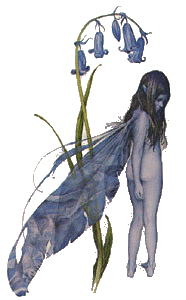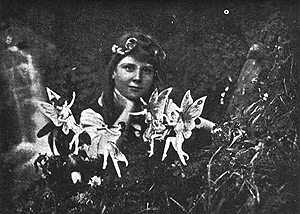Who are the fairy
folk of Irish Legend and popular belief?
Some believe they are fallen angels,
thrown out of heaven, who weren't quite
bad enough to be banished to hell. Some
believe they are the ancient gods of the
earth, the Tuatha
Dé Danann, who
when no longer worshipped and fed with
sacrifices, shrank to a diminutive size.
Irish historians say that the names of
their leaders are the same as the names
of the old Danan chiefs, and their
favorite gathering places are the old
Danan burial grounds.
They are called
'The Gentry" or "The good
people" by the Irish, who are
careful not to offend or anger them. It
is said that they are perilous to cross,
but also easily pacified by leaving a
saucer of milk out at night. Fairies can
take many forms... there are fairies of
the woodland, of the water, of the
meadows... dryads, leprechauns, pookas,
banchees... the list is extensive.
When they are
angry, they can paralyze men and cattle
with their fairy darts. When they are
happy, they can sing so beautifully, that
they bewitch anyone who hears them. It is
said that the most beautiful songs of
Ireland were fairy songs, overheard by
human eavesdroppers.
Sometimes the fairies will
steal away a beautiful mortal child and
leave an ugly, wizened little creature in
its place. These fairy changelings grow
up malicious and wicked, and have
voracious appetites.
The unhappy parents often
perform a 'test of fire' on the child to
determine if it is a changling. They lay
the child in the very center of the
house, light a fire all around him, and
watch to see if he changes into a sod of
turf. If the child survives this ordeal
it is accepted as one of the family,
although grudgingly; and he is generally
hated by the neighbors for his impish
ways.
The children of the Sidhe
and a mortal mother are always clever and
beautiful, and excel in music and
dancing. They are passionate and willful,
have strange, moody fits, and desire
solitude above all things, often seeming
to converse with unseen spiritual beings.
A young peasant woman is
occasionally carried off by the fairies
to nurse their fairy children. But the
woman is allowed to come back to her own
infant after sunset. To break the
fairies' enchantment, her husband must
immediately throw holy water over her in
the name of God. This will restore her to
her own shape.
Sometimes she will return
with a hissing noise like a serpent, and
appear black and shrouded like one who
has returned from the dead. In her own
shape, she will nurse her baby by the
fire. Her husband must ask no questions,
but give her food in silence.
If she falls asleep the
third night, all will be well - at this
point the husband can tie a red thread
across the doorway to prevent the fairies
from entering the house to retrieve her,
and if the third night passes safely, the
fairies have lost their power over her
for evermore.
Some types of fairies live
in communities, in the hollow hills, or
fairy mounds. Others are more solitary in
nature. These are the wizened, withered
unsociable fairies - homely, jeering,
mischievous, and just plain crafty. They
are the greatest practical jokers among
the little people.
The Leprechaun is the most
industrious of the fairy folk, known as a
shoe-maker. He is believed to be quite
rich from his industry, and thus buries
large pots of gold here and there, which
he jealously guards. In the early part of
this century, according to Croker, a
newspaper office in Tipperary used to
display a tiny shoe, believed to have
been left behind by a Leprechaun.
The Cluricaun gets drunk in
rich gentlemen's cellars. The Far Darrig,
otherwise known as the Red Man, (because
he wears a red cap and coat,) spends all
of his time playing nasty practical jokes
on unsuspecting passersby.
The Banshee is an attendant
fairy that follows the old Irish
families, and wails terribly before a
family death. She clasps her hands and
moans in a high keening wail, said to be
the model for the funeral cry of the
peasantry. When several banshee wail
together in chorus, it is believed to
herald the death of a very great leader
or saint.
The fairy folk
celebrate three festivals every year: May
Eve, Midsummer Eve, and November Eve. On
Midsummer Eve they are the happiest, and
sometimes steal away beautiful maidens to
be their brides. On November Eve they are
the gloomiest, but still dance with the
ghosts that walk the earth. The Pooka, a
large animal-like fairy, is abroad on
November Eve. After this night, it is
said that the blackberries are no longer
good to eat, for the Pooka has spoiled
them.

Real
or Imaginary?
The Celts have
known about the existence of fairies, or
nature spirits since Medieval times or
earlier. Celtic Shamans and spiritualists
(those with clairvoyant sight) can see a
variety of land, water and air spirits.
In his book "The
Secret Life of Nature,"
Peter Tompkins retells the story of the Cottingley Fairies,
and in particular describes the
clairvoyant experiences of one Major
Geoffrey Hodson, who Sir Conan Doyle
described as "an honorable gentleman
with neither the will to deceive nor any
conceivable object in doing so."

A purported
photo of the Cottingley Fairies
Hodson went to
Cottingley, and several other areas on
Britain known to be inhabited by nature
spirits, and described his experiences in
great detail. He described dryads (tree
spirits,) nyads (water spirits,)
brownies, elves, gnomes - flying,
plant-tending fairies and earth-dwelling
elementals. These fairies appeared to be
care-takers of the plants with which they
lived, helping them grow by in fusing
them with fairy life force.
In a garden at
Preston in October, 1921, Hodson
spotted a particularly lovely
fairy clothed in iridescent
shimmering light. " She is
decidedly fair in coloring,"
he noted, "full of laughter
and happiness, very open and
fearless in expression,
surrounded by an aura of golden
radiance in which the outline of
her wings can be traced. There is
also a hint of mockery in her
attitude and expression, as of
one who is enjoying a joke
against the poor mortals who are
studying her."
Suddenly, said
Hodson, her manner changed and
she became serious, giving him a
better notion of her function, by
stretching out her arms to
perform an act of concentration
that had the effect, as Hodson
witnessed it, of reducing the
size of her aura and of turning
it inward on herself. Having
maintained this condition for
about fifteen seconds, "she
releases the whole of the
concentration of energy, which
pours forth in all directions in
streams of golden force, and
appears to affect every single
stem and flower within its
reach."
- The Secret Life
of Nature, Peter
Tompkins
|
|